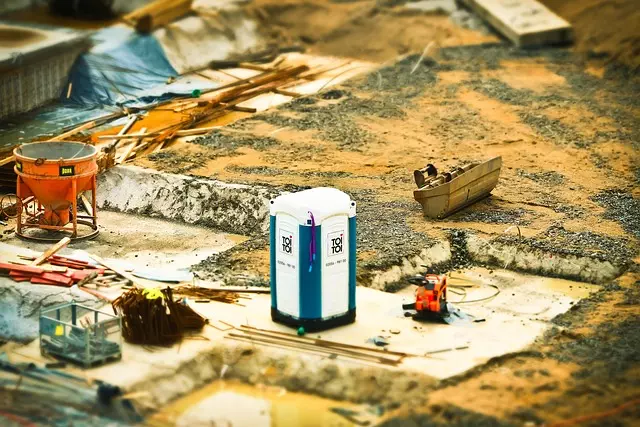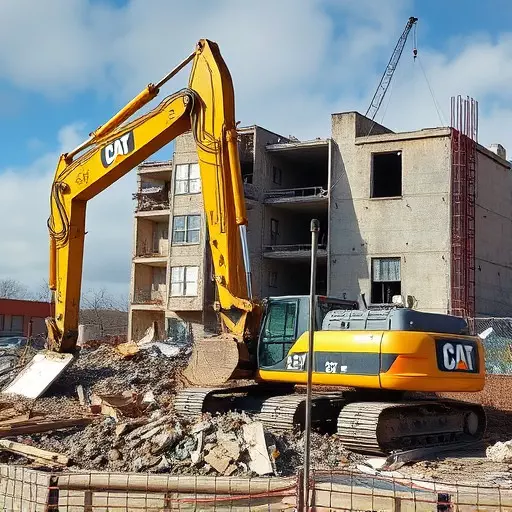Building deconstruction in Toledo offers a sustainable solution by transforming construction sites into resource hubs. Specialized teams carefully disassemble structures, recovering materials like wood, metal, concrete, and glass for repurposing, thereby reducing landfill waste and minimizing environmental impact. This method aligns with demolition and recycling services' goals, fostering a circular economy and promoting ecological stewardship in urban development. Through meticulous planning, collaboration, and deconstruction techniques, Toledo's industry leaders are revolutionizing construction practices to create a more sustainable future.
In today’s digital era, embracing sustainability in construction is more crucial than ever. End-of-life building recycling, through careful deconstruction, offers a game-changing approach to reduce environmental impact. This article delves into the process of understanding and maximizing resource recovery from building deconstruction projects, highlighting the vital role of demolition and recycling services in Toledo as a model for sustainable construction practices.
From planning efficient navigation of construction site demolitions to exploring best practices, we’ll explore why building deconstruction is an essential step towards a greener future.
- Understanding Building Deconstruction: A Key Step in End-of-Life Recycling
- The Role of Demolition and Recycling Services in Toledo: Unlocking Sustainable Construction
- Efficient Navigation: Planning a Construction Site Demolition Project
- Maximizing Resource Recovery: Best Practices for Building Deconstruction
- The Environmental Impact: Why Building Deconstruction is Essential for a Greener Future
Understanding Building Deconstruction: A Key Step in End-of-Life Recycling
Building deconstruction is a specialized process that involves carefully taking apart a structure instead of simply tearing it down. It’s a key step in end-of-life building recycling, as it allows for the recovery of valuable materials and components that can be reused or repurposed. By employing skilled professionals in demolition and recycling services Toledo has to offer, construction sites can be transformed from waste hotspots into sustainable resource hubs.
This meticulous approach ensures that materials like wood, metal, glass, and even concrete are identified, separated, and processed efficiently. The practice goes beyond traditional recycling by aiming to maximize the value of materials, reduce waste sent to landfills, and minimize the environmental impact associated with new construction. It’s a sustainable solution that contributes to a circular economy, where resources are continuously used and reused.
The Role of Demolition and Recycling Services in Toledo: Unlocking Sustainable Construction
In Toledo, the integration of efficient demolition and recycling services is pivotal in advancing sustainable construction practices. With a growing focus on environmental stewardship, these services play a crucial role in mitigating the ecological impact of construction and deconstruction processes. By employing specialized techniques and technologies, local experts transform end-of-life buildings into valuable resources for new constructions. This innovative approach not only reduces waste but also minimizes the need for virgin materials, fostering a circular economy.
The process begins with skilled professionals carefully disassembling structures, ensuring proper separation of materials like wood, metal, and concrete. This building deconstruction method allows for the recovery of high-quality reusable components, which can be recycled and repurposed. As a result, construction sites in Toledo are not only places of new beginnings but also contribute to a more sustainable future by unlocking the potential of recycled materials, creating a harmonious balance between urban development and environmental conservation.
Efficient Navigation: Planning a Construction Site Demolition Project
Efficient navigation is key when planning a construction site demolition project, especially with the goal of maximizing recycling and sustainable practices. A strategic approach begins with a thorough assessment of the building’s components and materials. This involves identifying reusable or recyclable items like wood, metal, concrete, and insulation. Specialized teams employ deconstruction methods to carefully disassemble structures, ensuring materials are preserved for future use.
By employing these techniques, demolition and recycling services in Toledo can significantly reduce the environmental impact of construction projects. Proper planning allows for efficient sorting and processing of materials at the site or through partnerships with specialized facilities. This not only minimizes waste but also creates a valuable resource pool, promoting circular economy practices in the construction industry.
Maximizing Resource Recovery: Best Practices for Building Deconstruction
Maximizing Resource Recovery: Best Practices for Building Deconstruction
In the realm of sustainable construction and demolition, building deconstruction stands out as a game-changer. Unlike traditional demolition that often leads to vast amounts of waste, deconstruction is a meticulous process focused on resource recovery. By employing specialized demolition and recycling services in Toledo, builders and architects can ensure that materials from older structures are reused or recycled, reducing the environmental impact of construction sites significantly. This approach not only minimizes waste but also provides access to high-quality, affordable building materials for new projects.
Best practices in building deconstruction involve careful planning and collaboration between various stakeholders. It begins with a thorough assessment of the structure to identify materials suitable for recycling or reuse. Demolition experts use specialized equipment and techniques to disassemble buildings rather than simply tearing them down, preserving valuable components like wood, metal, and concrete. These recovered materials are then processed and prepared for repurposing, ensuring they meet quality standards. By adopting these practices, construction sites in Toledo can contribute to a circular economy, where waste becomes a valuable resource, fostering sustainability in the building industry.
The Environmental Impact: Why Building Deconstruction is Essential for a Greener Future
In today’s world, where environmental sustainability is a paramount concern, the way we manage our built environment at the end of its life cycle plays a pivotal role in shaping a greener future. Building deconstruction, as an alternative to traditional demolition, offers a sustainable solution by maximizing resource recovery and minimizing waste. This eco-friendly approach involves carefully disassembling structures instead of tearing them down, allowing for the salvage and recycling of valuable materials such as wood, metal, concrete, and insulation.
By employing building deconstruction methods, particularly in urban areas like Toledo where construction site demolition is prevalent, we can significantly reduce the environmental impact of our built environment. This practice not only conserves natural resources but also diminishes the energy consumption and greenhouse gas emissions associated with manufacturing new materials. Moreover, it fosters a circular economy by creating opportunities for recycled materials to be reused in other projects, ensuring a more sustainable and resilient future for both our communities and the planet.


